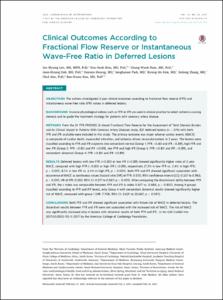KUMEL Repository
1. Journal Papers (연구논문)
1. School of Medicine (의과대학)
Dept. of Internal Medicine (내과학)
Clinical Outcomes According to Fractional Flow Reserve or Instantaneous Wave-Free Ratio in Deferred Lesions
- Keimyung Author(s)
- Nam, Chang Wook
- Department
- Dept. of Internal Medicine (내과학)
- Journal Title
- JACC. Cardiovascular Interventions
- Issued Date
- 2017
- Volume
- 10
- Issue
- 24
- Keyword
- coronary artery disease; discordance; fractional flow reserve; instantaneous wave free ratio; ischemia; prognosis
- Abstract
- OBJECTIVES:
The authors investigated 2-year clinical outcomes according to fractional flow reserve (FFR) and instantaneous wave-free ratio (iFR) values in deferred lesions.
BACKGROUND:
Invasive physiological indices such as FFR or iFR are used in clinical practice to select ischemia-causing stenosis and to guide the treatment strategy for patients with coronary artery disease.
METHODS:
From the 3V FFR-FRIENDS (3-Vessel Fractional Flow Reserve for the Assessment of Total Stenosis Burden and Its Clinical Impact in Patients With Coronary Artery Disease) study, 821 deferred lesions (n = 374) with both FFR and iFR available were included in this study. The primary outcome was major adverse cardiac events (MACE) (a composite of cardiac death, myocardial infarction, and ischemia-driven revascularization) at 2 years. The lesions were classified according to FFR and iFR cutpoints into concordant normal (Group 1: FFR >0.80 and iFR >0.89), high FFR and low iFR (Group 2: FFR >0.80 and iFR ≤0.89), low FFR and high iFR (Group 3: FFR ≤0.80 and iFR >0.89), and concordant abnormal (Group 4: FFR ≤0.80 and iFR ≤0.89).
RESULTS:
Deferred lesions with low FFR (≤0.80) or low iFR (≤0.89) showed significantly higher rates of 2-year MACE, compared with high FFR (>0.80) or high iFR (>0.89), respectively (7.2% in low FFR vs. 2.4% in high FFR; p < 0.001; 8.1% in low iFR vs. 2.4% in high iFR; p < 0.001). Both FFR and iFR showed significant association with occurrence of MACE as continuous values (hazard ratio [HR] of FFR: 0.570, 95% confidence interval [CI]: 0.337 to 0.963; p < 0.001; HR of iFR: 0.350, 95% CI: 0.217 to 0.567; p < 0.001). When comparing the discriminant ability between FFR and iFR, the c-index was comparable between FFR and iFR (c-index 0.677 vs. 0.685; p = 0.857). Among 4 groups classified according to FFR and iFR levels, only Group 4 with concordant abnormal results showed significantly higher risk of MACE, compared with group 1 (HR: 7.708, 95% CI: 2.621 to 22.667; p < 0.001).
CONCLUSIONS:
Both FFR and iFR showed significant association with future risk of MACE in deferred lesions. The discordant results between FFR and iFR were not associated with the increased risk of MACE. The risk of MACE was significantly increased only in lesions with abnormal results of both FFR and iFR.
Copyright © 2017 American College of Cardiology Foundation. Published by Elsevier Inc. All rights reserved.
- Keimyung Author(s)(Kor)
- 남창욱
- Publisher
- School of Medicine (의과대학)
- Citation
- Joo Myung Lee et al. (2017). Clinical Outcomes According to Fractional Flow Reserve or Instantaneous Wave-Free Ratio in Deferred Lesions. JACC. Cardiovascular Interventions, 10(24), 2502–2510. doi: 10.1016/j.jcin.2017.07.019
- Type
- Article
- ISSN
- 1936-8798
- Appears in Collections:
- 1. School of Medicine (의과대학) > Dept. of Internal Medicine (내과학)
- 파일 목록
-
-
Download
 oak-2018-0241.pdf
기타 데이터 / 835.93 kB / Adobe PDF
oak-2018-0241.pdf
기타 데이터 / 835.93 kB / Adobe PDF
-
Items in Repository are protected by copyright, with all rights reserved, unless otherwise indicated.